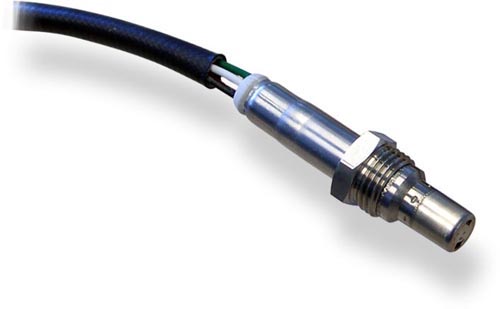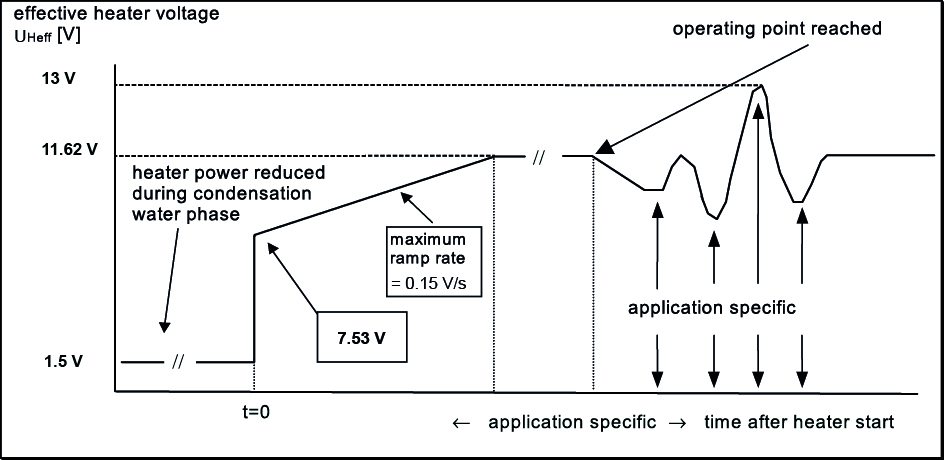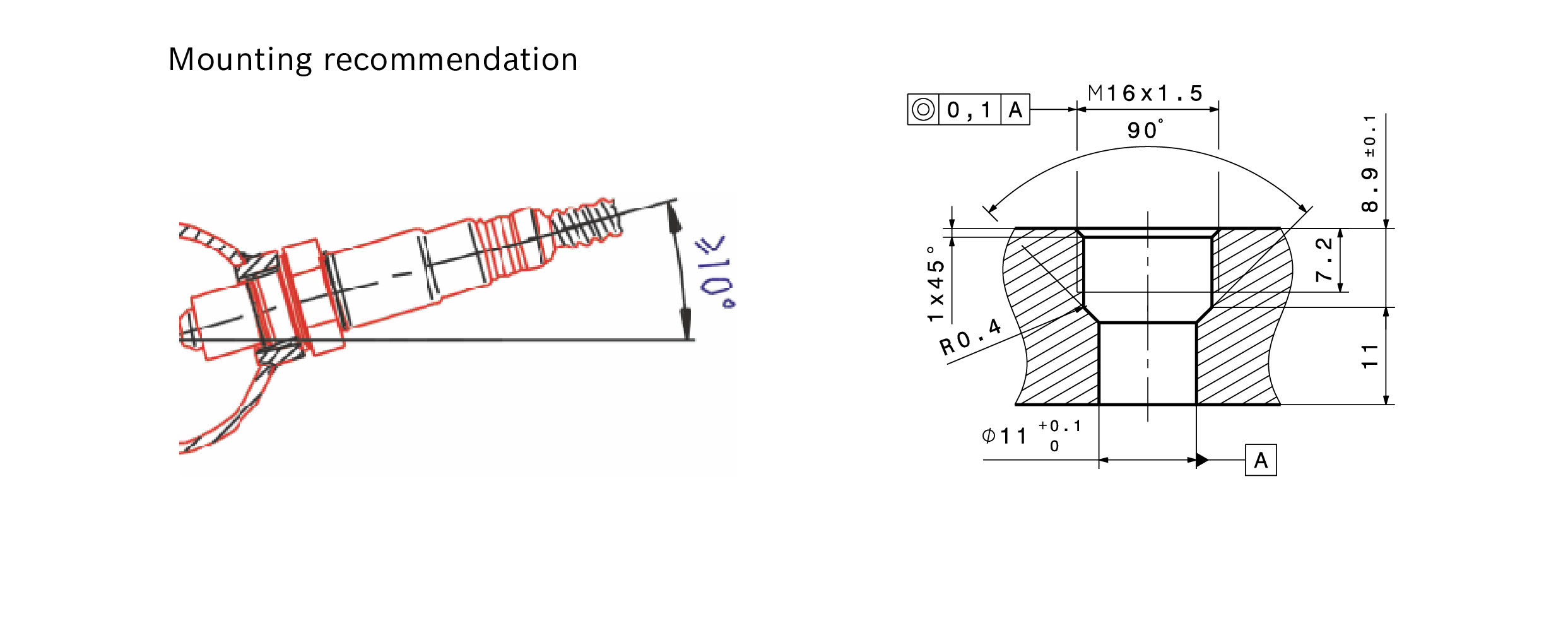
This sensor is designed to measure the proportion of oxygen in exhaust gases of automotive engines (gasoline or Diesel).
The wide band lambda sensor Mini-LSU 4.9 is a planar ZrO2 dual cell limiting current sensor with integrated heater. Its monotonic output signal in the range of lambda = 0.65 to air makes the LSU capable of being used as a universal sensor for lambda = 1 measurement as well as for lean and rich ranges.
The connector housing contains a trimming resistor, which defines the characteristic of the sensor. The main benefit of the Mini-LSU 4.9 is its very compact design in combination with the high Bosch production quality standard. The Mini-LSU is produced and tested in a handmade process.
The complete light weight housing is made of Inconel which makes it resistant against high temperatures. The sensor element is more than 50 % smaller than it is in the production lambda sensor. It is connected over silver coated steel cables to make it more reliable against vibrations.
This lambda sensor operates only in combination with a special LSU-IC, used in most Bosch Motorsport ECUs and lambda control units like LT4. You’ll find this unit and more on our homepage at Electronics/Sensor Interfaces.
- Downloads
- Features
- Application
- Technical Specifications
- Installation Notes
- Ordering Information
- Dimensions
- Legal Restrictions
Downloads
Features
- Application: lambda 0.65 to ∞
- Exhaust gas temperature: 930°C (1,030 for a short time)
- Hexagon temperature: 700°C
- Thread: M16x1.5
- Weight w/o wire: 34 g
Application
Application | lambda 0.65 to ∞ |
Fuel compatibility | gasoline/Diesel/E85 |
Exhaust gas pressure | ≤ 2.5 bar (higher with decrease accuracy) |
Exhaust gas temperature range (operating) | < 930°C |
Exhaust gas temperature range (max.) for short time | < 1,030°C |
Hexagon temperature | ≤ 700°C |
Wire and protective sleeve temperature | < 250°C |
Connector temperature | < 150°C |
Storage temperature range | -40 to 100°C |
Max. vibration (stochastic peak level) | 300 m/s2 (see Installation Notes) |
Technical Specifications
Variations
Mini-LSU 4.9 with automotive connector | |
Connector | 1928.404.682 |
Mating connector | D261.205.356-01 |
Wire length L | 950 mm |
Mini-LSU 4.9 with motorsport connector | |
Connector | AS607-35PN |
Mating connector | AS007-35SN |
Wire length L | 200 to 1,400 mm |
Mechanical Data
Weight w/o wire | 34 g |
Thread | M16x1.5 |
Wrench size | 17 mm |
Tightening torque | 60 Nm |
Electrical Data
Power supply H+ nominal | 7.5 V |
System supply voltage H+ (min) | 10.8 V |
Heater power steady state | 7.5 W |
Heater control frequency | 100 Hz |
Nominal resistance of Nernst cell | 300 Ohm |
Max. current load for Nernst cell | 250 µA |
Characteristic
Signal output | IP meas | |||
Accuracy at lambda 0.8 | 0.80 ± 0.01 | |||
Accuracy at lambda 1 | 1.016 ± 0.007 | |||
Accuracy at lambda 1.7 | 1.70 ± 0.05 | |||
I P [mA] | lambda | U A [V], v=17 | U A [V], v=8 | |
-2.000 | 0.650 | - | 0.510 | |
-1.602 | 0.700 | - | 0.707 | |
-1.243 | 0.750 | 0.192 | 0.884 | |
-0.927 | 0.800 | 0.525 | 1.041 | |
-0.800 | 0.822 | 0.658 | 1.104 | |
-0.652 | 0.850 | 0.814 | 1.177 | |
-0.405 | 0.900 | 1.074 | 1.299 | |
-0.183 | 0.950 | 1.307 | 1.409 | |
-0.106 | 0.970 | 1.388 | 1.448 | |
-0.040 | 0.990 | 1.458 | 1.480 | |
0 | 1.003 | 1.500 | 1.500 | |
0.015 | 1.010 | 1.515 | 1.507 | |
0.097 | 1.050 | 1.602 | 1.548 | |
0.193 | 1.100 | 1.703 | 1.596 | |
0.250 | 1.132 | 1.763 | 1.624 | |
0.329 | 1.179 | 1.846 | 1.663 | |
0.671 | 1.429 | 2.206 | 1.832 | |
0.938 | 1.701 | 2.487 | 1.964 | |
1.150 | 1.990 | 2.710 | 2.069 | |
1.385 | 2.434 | 2.958 | 2.186 | |
1.700 | 3.413 | 3.289 | 2.342 | |
2.000 | 5.391 | 3.605 | 2.490 | |
2.150 | 7.506 | 3.762 | 2.565 | |
2.250 | 10.119 | 3.868 | 2.614 | |
Please note: UA is not an output signal of the lambda sensor, but the output of the evaluation circuit. Only IP correlates with the oxygen content of the exhaust gas. Amplification factor v=17 is typically used for lean applications (lambda>1), amplification factor v=8 is typically used for rich applications (lambda<1). | ||||
Heater Strategy

Resistance/LSU Temperature
R (Ohm) | Temp (°C) |
80 | 1030 |
150 | 888 |
200 | 840 |
250 | 806 |
300 [operating point] | 780 |
350 | 761 |
400 | 744 |
450 | 729 |
550 | 703 |
650 | 686 |
800 | 665 |
1000 | 642 |
1200 | 628 |
2500 | 567 |
Connectors and Wires
Connector | Please see variations |
Mating connector | Please see variations |
Sleeve | fiber glass / silicone coated |
Pin 1 | Pump current APE / IP |
Pin 2 | Virtual ground IPN / VM |
Pin 3 | Heater voltage H- / Uh- |
Pin 4 | Heater voltage H+ / Uh+ |
Pin 5 | Trim resistor RT / IA |
Pin 6 | Nernst voltage UN / RE |
Wire length | Please see variations |
Various motorsport and automotive connectors are available on request. | |
Installation Notes
This lambda sensor operates only in combination with a special LSU-IC, used in most Bosch Motorsport ECUs and lambda control units like LT4. You’ll find this unit and more on our homepage at Accessories/Expansion Modules. |
The lambda sensor should be installed at point which permits the measurement of a representative exhaust-gas mixture and which does not exceed the maximum permissible temperature. |
Install at a point where the gas is as hot as possible. |
Observe the maximum permissible temperature. |
Sensors should be installed as close to vertical as possible (wire upwards). |
The sensor is not to be fitted near to the exhaust pipe outlet, so that the influence of the outside air can be ruled out. |
The exhaust system up stand and surrounding the sensor must be sealed in order to avoid the effects of leakage air. |
Protect the sensor against condensation water. The sensor is not to be painted, nor is wax to be applied or any other forms of treatment. Use only the recommended grease for lubricating the thread. |
Please find further application hints in the offer drawing at our homepage. |
A higher maximum vibration profile is possible and should be determined by the customer’s individual application. |
Safety Note
The sensor is not intended to be used for safety related applications without appropriate measures for signal validation in the application system. |
Ordering Information
Lambda Sensor Mini-LSU 4.9
With automotive connector
Order number: B258.490.103-30
Lambda Sensor Mini-LSU 4.9
With motorsport connector
Order number: F02U.V02.227-02
Dimensions


Legal Restrictions
Due to embargo restrictions, sale of this product in Russia, Belarus, Iran, Syria, Libya, Afghanistan, and North Korea is prohibited.
